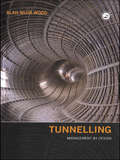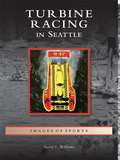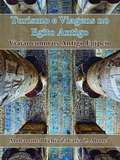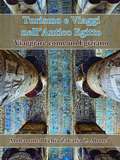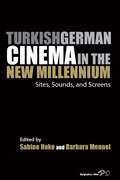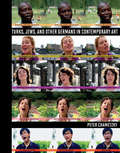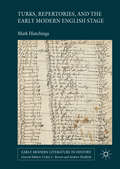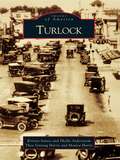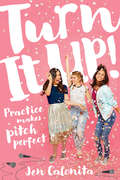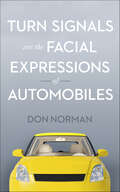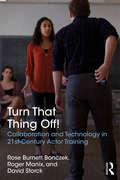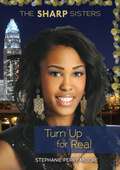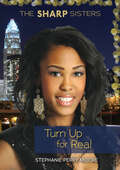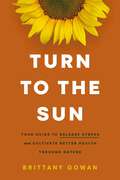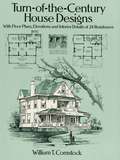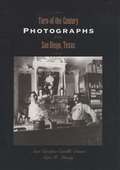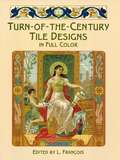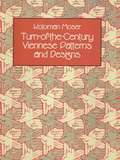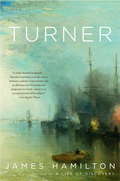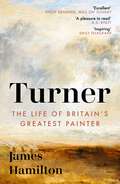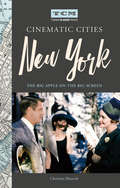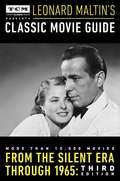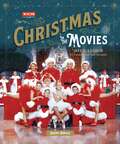- Table View
- List View
Tunnelling: Management by Design
by Alan Muir WoodTunnelling has become a fragmented process, excessively influenced by lawyers'notions of confrontational contractual bases. This prevents the pooling of skills, essential to the achievement of the promoters' objectives. Tunnelling: Management by Design seeks the reversal of this trend. After a brief historical treatment of selected developments, th
Turbine Racing in Seattle (Images of Sports)
by David D. WilliamsHydroplane racing captured the heart and soul of Seattle in the early 1950s and never let go. No Seahawks, Sonics, or Mariners game has come close to drawing one-quarter of the audience that watches the hydroplanes race. The unmistakable sound of the boats' huge motors was as big an attraction as the racing itself. In the mid-1980s, something began to change. The distinctive roar of the old Thunderboats gave way to the whoosh of the turbine. The old names like Muncey and Chenoweth were replaced by new names like Hanauer and Villwock.
Turismo e Viagem no Egito Antigo
by Andrea Cruz Miranda Goodall Mohammed Yehia Z. Ahmed"Dai pão a quem tem fome, água a quem tem sede, vista quem não tem roupa e um barco para aqueles que não têm [...]". Este é um texto egípcio antigo, que mostra como viajar era uma atividade humana impotante nos tempos antigos. Os estudiosos classificaram agora mobilidade para viagens e turismo. Além disso, existem vários tipos e finalidades de turismo e viagens e este não era o mesmo entre os primeiros países consequentemente mudando ao longo do tempo. O livro “Turismo e Viagem no Egito Antigo” levanta muitas perguntas que nós ainda não temos respostas precisas. Portanto, este livro tem como objetivo investigar estas preocupações. Para responder a estas perguntas, foram selecionadas as abordagens analíticas e descritivas para realizar o trabalho. Isso inclui análises das pinturas nas paredes dos túmulos e templos onde são consideradas as fontes ilustrativas, bem como as fontes textuais com base na literatura e escritos egípcios. O livro conclui que a viagem era algo corriqueiro no antigo Egito desde os tempos pré-dinásticos. Ao aplicar os termos e noção da indústria do turismo contemporânea, de fato, os antigos egípcios conheciam diversas formas de turismo e viagens, tais como viagens domésticas e internacionais, lazer, negócios e viagens de aventura.
Turismo e Viaggio nell'Antico Egitto
by Mohammed Yehia Z. Ahmed E. A.“Dai pane agli affamati, acqua agli assetati, vestiti ai nudi e una barca a chi non ne ha […]”. Questo antico tesyo egizio mostra come il viaggio fosse una attività significativa nei tempi antichi. Gli studiosi hanno classificato la mobilità del viaggio e del turismo. Inoltre, esistono diversi tipi e obiettivi di viaggio e Turismo e questo non accadeva per tutte le nazioni, cambiano anche nel corso del tempo. Il viaggio in Antico Egitto solleva molte domande, ancora senza risposta; per questo, il libro tenta di investigare su questi argomenti. Per rispondere, si utilizza un approccio analitico e descrittivo. Si analizzano altresì i dipinti delle tombe e dei templi, considerati come risorse pittoriche, così come le fonti scritte della letteratura e dei testi egiziani. Applicando i concetti e la nozione di turismo in chiave contemporanea, invece, risulta che gli Egiziani conoscessero diverse forme di turismo e di viaggio, come il viaggio domestico e internazionale, viaggio di piacere, d’affari e d’avventura. Il nuovo libro presenta una ricerca circa uno dei più antichi e misteriosi argomenti della cultura egizia, finora poco trattato. Si parla del “viaggio nell’Antico Egitto”, incontrando così gli interessi non solo degli Egittologi, degli studiosi di turismo e storia, ma anche di tutte quelle persone e dei lettori interessati a riconoscere somiglianze e differenze del viaggio del mondo antico e moderno.
Turkish German Cinema in the New Millennium
by Sabine Hake Barbara MennelIn the last five years of the twentieth century, films by the second and third generation of the so-called German guest workers exploded onto the German film landscape. Self-confident, articulate, and dynamic, these films situate themselves in the global exchange of cinematic images, citing and rewriting American gangster narratives, Kung Fu action films, and paralleling other emergent European minority cinemas. This, the first book-length study on the topic, will function as an introduction to this emergent and growing cinema and offer a survey of important films and directors of the last two decades. In addition, it intervenes in the theoretical debates about Turkish German culture by engaging with different methodological approaches that originate in film studies.
Turks, Jews, and Other Germans in Contemporary Art
by Peter ChametzkyThe first book to examine multicultural visual art in Germany, discussing more than thirty contemporary artists and arguing for a cosmopolitan Germanness.With Turks, Jews, and Other Germans in Contemporary Art, Peter Chametzky presents a view of visual culture in Germany that leaves behind the usual suspects--those artists who dominate discussions of contemporary German art, including Gerhard Richter, Anselm Kiefer, and Rosemarie Trockel--and instead turns to those artists not as well known outside Germany, including Maziar Moradi, Hito Steyerl, and Tanya Ury. In this first book-length examination of Germany's multicultural art scene, Chametzky explores the work of more than thirty German artists who are (among other ethnicities) Turkish, Jewish, Arab, Asian, Iranian, Sinti and Roma, Balkan, and Afro-German. With a title that echoes Peter Gay's 1978 collection of essays, Freud, Jews and Other Germans, this book, like Gay's, rejects the idea of "us" and "them" in German culture. Discussing artworks in a variety of media that both critique and expand notions of identity and community, Chametzky offers a counternarrative to the fiction of an exclusively white, Christian German culture, arguing for a cosmopolitan Germanness. He considers works that deploy critical, confrontational, and playful uses of language, especially German and Turkish; that assert the presence of "foreign bodies" among the German body politic; that grapple with food as a cultural marker; that engage with mass media; and that depict and inhabit spaces imbued with the element of time. American discussions of German contemporary art have largely ignored the emergence of non-ethnic Germans as some of Germany's most important visual artists. Turks, Jews, and Other Germans in Contemporary Art fills this gap.
Turks, Repertories, and the Early Modern English Stage (Early Modern Literature in History)
by Mark HutchingsThis book considers the relationship between the vogue for putting the Ottoman Empire on the English stage and the repertory system that underpinned London playmaking. The sheer visibility of 'the Turk' in plays staged between 1567 and 1642 has tended to be interpreted as registering English attitudes to Islam, as articulating popular perceptions of Anglo-Ottoman relations, and as part of a broader interest in the wider world brought home by travellers, writers, adventurers, merchants, and diplomats. Such reports furnished playwrights with raw material which, fashioned into drama, established ‘the Turk’ as a fixture in the playhouse. But it was the demand for plays to replenish company repertories to attract London audiences that underpinned playmaking in this period. Thus this remarkable fascination for the Ottoman Empire is best understood as a product of theatre economics and the repertory system, rather than taken directly as a measure of cultural and historical engagement.
Turlock (Images of America)
by Thea Sonntag Harris Kristen Santos Monica Harris Phyllis SoderstromTurlock, like many communities across America, can trace its early development to one individual. John William Mitchell, wheat producer and entrepreneur, brought the Southern Pacific Railroad and a depot to what would become Turlock. This transportation link was the catalyst that brought business proprietors and settlers to the area and changed the 1850s settlement into an organized town. At the turn of the 20th century, the Turlock Irrigation district, the first California district under the Wright Act of 1887, brought water to the valley. A dam and system of canals provided the needed resources for crop diversification and the development of agricultural industry that changed the small town into a culturally rich, successful city. This volume focuses on the evolution of Turlock from the 1850s to 1950s.
Turn It Up!: Practice Makes Pitch Perfect
by Jen CalonitaFrom the author of the Fairy Tale Reform School and the Belles series comes a contemporary YA that sings with hilarity and fun.The Nightingales are in a serious funk. Bradley Academy's all-girl a cappella group used to be the pride of the sunshine state, but the Nightingales have recently fallen out of harmony. Best friends and co-captains Lidia Sato and Sydney Marino haven't been speaking ever since a boy came between them. And not just any boy-none other than Griffin Mancini, the lead singer of Bradley Academy's smug all-boy a capella group, the Kingfishers. The Nightingales have no chance of making it to the big state final if their captains are at each other's throats. Their only hope is new girl Julianna Ramirez. But in addition to her serious pipes, she has some serious stage fright. The Nightingales will have to come together if they want to shine at the upcoming competition and restore the group to its former glory.Turn It Up! follows Lidia, Sydney, and Julianna through the ups and downs of friendship, romance, competition, and finding the perfect song!
Turn Signals Are the Facial Expressions of Automobiles
by Don NormanBy the author of THE DESIGN OF EVERYDAY THINGS. For decades, Don Norman has spoken the language of gadgets, explaining how the things we see every day are made and made better. In this smart, sharp, fun exploration of design, Norman pulls back the curtain on the things we make to make our lives easier. From water faucets and airplane cockpits to the concept of "real time" and the future of memory, this wide-ranging tour through technology provides a new understanding of how the gadgets that surround us affect our lives. Donald A. Norman explores the plight of humans living in a world ruled by a technology that seems to exist for its own sake, oblivious to the needs of the people who create it. TURN SIGNALS is an intelligent, whimsical, curmudgeonly look at our love/hate relationship with machines, as well as a persuasive call for the humanization of modern design.
Turn That Thing Off!: Collaboration and Technology in 21st-Century Actor Training
by Rose Burnett Bonczek Roger Manix David StorckAs personal technology becomes ever-present in the classroom and rehearsal studio, its use and ubiquity is affecting the collaborative behaviors that should underpin actor training. How is the collaborative impulse being distracted and what kind of solutions can re-establish its connections? The daily work of a theater practitioner thrives on an ability to connect, empathize, and participate with other artists. This is true at every level, from performing arts students to established professionals. As smartphones, social media, and other forms of digital connectedness become more and more embedded in daily life, they can inhibit these collaborative, creative skills. Turn That Thing Off! Collaboration and Technology in 21st-Century Actor Training explores ways to foster these essential abilities, paving the way for emerging performers to be more present, available, and generous in their work.
Turn Up for Real (The Sharp Sisters #3)
by Stephanie Perry MooreSlade, Stanley Sharp's middle daughter, feels like the odd one out. All she wants is a group of friends who aren't her sisters—and a record deal. But after losing the Teen Miss Charlotte competition and having a bad experience at a recording studio, Slade feels her dreams slipping away. Can Slade be an advocate for the arts and a singing superstar, or is she just another pretty face?
Turn Up for Real (The\sharp Sisters Ser.)
by Stephanie Perry MooreSlade, Stanley Sharp's middle daughter, feels like the odd one out. All she wants is a group of friends who aren't her sisters—and a record deal. But after losing the Teen Miss Charlotte competition and having a bad experience at a recording studio, Slade feels her dreams slipping away. Can Slade be an advocate for the arts and a singing superstar, or is she just another pretty face?
Turn to the Sun: Your Guide to Release Stress and Cultivate Better Health Through Nature
by Brittany GowanTurn to the Sun guides you down a nourishing path of uplifting affirmations, soul-refreshing meditations, and lush botanical photography that helps you heal in the company of nature. Approach your days with less anxiety, renewed vigor, and a deeper sense of well-being as you become grounded and soak up nature's restorative qualities.Whether you live in an urban jungle, on a suburban cul-de-sac, or at the edge of a national forest, you might find yourself more connected to technology than to nature. In the midst of the pings and rings of a device-dependent life, is getting close to nature even possible—or worth it?Wellness coach and the founder of Pause with Plants Brittany Gowan shows you how slowing down, unplugging, and connecting with the natural world is not only possible and absolutely worth it, but also essential. Brittany creates a reflective experience enhanced by plants that helps you find the calm and tranquility you crave.In these gorgeous, photo-filled pages, you'll find ways to:Cultivate mindfulness as you let go of daily distractionsLet nature guide you into relishing the present momentUse a nature-focused mindset to persist through challengesConnect and ground yourself with nature anywhere, anytimeNourish your relationship with yourself and the world around you Turn to the Sun includes:Affirmations: simple statements that have a positive effect on your thoughts and actionsMeditations: guidance for reflection and contemplation to center your mind and bodyHow-tos: doable exercises to fully engage with the natural worldStunning botanical photography: lush images of plants that pair with affirmations, meditations, and how-tos When in your life have you felt most alive? You can feel that way again. You can flourish, with purpose, whether you are in a waiting season or ready to blossom. It's time to pause. It's time to breathe. It's time to grow.
Turn-of-the-Century Farm Tools and Implements
by Henderson Co.Published in 1898, this abundantly illustrated trade catalog advertised tools, fertilizers, insecticides, and other essentials for the turn-of-the-century garden, farm, greenhouse, lawn, orchard, poultry yard, stable, and household. Includes butter printers, cast-iron field rollers, broadcast seeders, corn harvesters and huskers, root cutters, cider mills, veterinary remedies, and more. Approximately 680 black-and-white illustrations.
Turn-of-the-Century House Designs: With Floor Plans, Elevations and Interior Details of 24 Residences
by William T. ComstockThis inexpensive archive of handsome turn-of-the-century designs reprinted directly from a rare late Victorian volume contains plans for a variety of suburban and country homes that are both aesthetically appealing and moderate in cost. Included are plans for 24 cottages and houses in a wide range of styles, among them Queen Anne, Eastlake, and Colonial. Over 130 illustrations — floor plans, elevations, perspective views, and more — enhance the text, which is further supplemented by two informative and useful articles: "Suggestions on House Building," by A. W. Cobb, describes the process of building a home, from the first sketches offered by the architect to his client, to property selection, scale drawings, and details of construction. “How to Plumb a Suburban House,” by Leonard D. Hosford, provided the late Victorian era homeowner with valuable advice about sewage disposal.Restorers of old houses, preservationists, and students of American architectural history will welcome this treasury of authentic century-old plans and details. Students of social history will also find it an excellent reference.
Turn-of-the-Century Photographs from San Diego, Texas
by Ana Carolina Castillo Crimm Sara R. MasseySituated in the South Texas borderlands some fifty miles west of Corpus Christi, San Diego was a thriving town already a hundred years old at the turn of the twentieth century. With a population that was 90 percent Mexican or Mexican American and 10 percent Anglo, the bicultural community was the seat of Duval County and a prosperous town of lumberyards, banks, mercantile stores, and cotton gins, which also supplied the needs of area ranchers and farmers. Though Anglos dominated its economic and political life, San Diego was culturally Mexican, and Mexican Americans as well as Anglos built successful businesses and made fortunes. This collection of nearly one hundred photographs from the estate of amateur photographer William Hoffman captures the cosmopolitan town of San Diego at a vibrant moment in its history between 1898 and 1909. Grouped into the categories women and their jobs, local homes, men and their businesses, children at school and church, families and friends, and entertainment about town, the photos offer an immediate visual understanding of the cultural and economic life of the community, enhanced by detailed captions that identify the subjects and circumstances of the photos. An introductory historical chapter constitutes the first published history of Duval County, which was one of the most important areas of South Texas in the early twentieth century.
Turn-of-the-Century Tile Designs in Full Color
by L. FrancoisCarefully selected from a rare 1905 French tile catalog, this splendid full-color collection of tile designs features scores of eye-catching motifs. A valuable resource for today's artists and designers, this volume of authentic images can also serve as inspiration for craftspeople working in a variety of areas. The 250 illustrations include panels and borders of all sizes, decorated with lotus blossoms, lilies-of-the-valley, irises, and other delicate florals; multicolored designs promoting meat markets, dairies, and other commercial establishments; decorative wall tiles for bathrooms; stenciled friezes with ornate floral and foliate motifs; vibrantly colored enameled squares; geometrics; and much more. Rich in Art Nouveau flavor and elegance, these versatile copyright-free designs not only constitute an invaluable archive of usable art and design inspiration but also a magnificent browsing book for lovers of the decorative arts.
Turn-of-the-Century Viennese Patterns and Designs
by Koloman MoserStunning sourcebook of 60 full-page, royalty-free designs -- 30 in full color and 30 in black-and-white -- depict a marvelous selection of allover, subtly colored patterns for textiles, wallpaper, rugs, and wall hangings. Imaginative, Art Nouveau-inspired renderings of ferns, flowers, berries, human figures, masks, exotic dancers and a host of other subjects.
Turner
by James HamiltonJ. M. W. Turner was a painter whose treatment of light put him squarely in the pantheon of the world's preeminent artists, but his character was a tangle of fascinating contradictions. While he could be coarse and rude, manipulative, ill-mannered, and inarticulate, he was also generous, questioning, and humane, and he displayed through his work a hitherto unrecognized optimism about the course of human progress. With two illegitimate daughters and several mistresses whom Turner made a career of not including in his public life, the painter was also known for his entrepreneurial cunning, demanding and receiving the highest prices for his work. Over the course of sixty years, Turner traveled thousands of miles to seek out the landscapes of England and Europe. He was drawn overwhelmingly to coasts, to the electrifying rub of the land with the sea, and he regularly observed their union from the cliff, the beach, the pier, or from a small boat. Fueled by his prodigious talent, Turner revealed to himself and others the personality of the British and European landscapes and the moods of the surrounding seas. He kept no diary, but his many sketchbooks are intensely autobiographical, giving clues to his techniques, his itineraries, his income and expenditures, and his struggle to master the theories of perspective. In Turner, James Hamilton takes advantage of new material discovered since the 1975 bicentennial celebration of the artist's birth, paying particular attention to the diary of sketches with which Turner narrated his life. Hamilton's textured portrait is fully complemented by a sixteen-page illustrations insert, including many color reproductions of Turner's most famous landscape paintings. Seamlessly blending vibrant biography with astute art criticism, Hamilton writes with energy, style, and erudition to address the contradictions of this great artist. From the Hardcover edition.
Turner - A Life
by James HamiltonThe definitive biography of J.M.W. Turner.'A pleasure to read'.' A.S. BYATT'With splendid clarity and shrewd humour, James Hamilton evokes the visceral world of a great artist and a fascinating character.' MIKE LEIGHIn 1799, aged just 24, Turner became an Associate of the Royal Academy. While influential collectors competed to buy his paintings, he travelled widely, observing landscape and people and gathering material for a cycle of images that would come to express the collective identity of Britain. In this lucid blend of vibrant biography and acute art history, James Hamilton introduces Turner to a new generation of readers and paints a picture of a uniquely generous human being, a giant of the nineteenth century and a beacon for the twenty-first.
Turner - A Life
by James HamiltonJ.M.W Turner exhibited his work proudly but was correspondingly reticent about his private life. In 1799, aged 24, he became an Associate of the Royal Academy at the youngest possible age. While influential collectors competed to buy his paintings, Turner travelled widely, observing landscape and people, and collecting material for a cycle of images that would come to express the collective identity of Britain. In this lucid blend of vibrant biography and acute art history, James Hamilton introduces Turner to a new generation of readers and paints a picture of a uniquely generous human being, a giant of the nineteenth century and a beacon for the twenty-first.
Turner Classic Movies Cinematic Cities: The Big Apple on the Big Screen (Turner Classic Movies)
by Christian BlauveltFor armchair travelers, film buffs, tourists, and city dwellers alike, Turner Classic Movies takes you on a one-of-a-kind tour of the cinematic sites of New York City.Highlighting the great films set in the Big Apple since the dawn of cinema to the present, Cinematic Cities: New York City is both a trove of information including behind-the-scenes stories and trivia, and a practical guide full of tips on where to go, eat, drink, shop, and sleep to follow along the path of your favorite films set in NYC. Organized by neighborhood and featuring photographs and illustrated maps throughout, this is a love letter to the city and a one-of-a-kind history of the movies.Featured films and locations include The Godfather, The Seven Year Itch, King Kong, North by Northwest, On the Town, West Side Story, When Harry Met Sally, the films of Woody Allen, and scores of others.
Turner Classic Movies Presents Leonard Maltin's Classic Movie Guide: Third Edition
by Leonard MaltinThe definitive guide to classic films from one of America's most trusted film criticsThanks to Netflix and cable television, classic films are more accessible than ever. <P><P>Now co-branded with Turner Classic Movies, Leonard Maltin's Classic Movie Guide covers films from Hollywood and around the world, from the silent era through 1965, and from The Maltese Falcon to Singin' in the Rain and Godzilla, King of the Monsters!<P>Thoroughly revised and updated, and featuring expanded indexes, a list of Maltin's personal recommendations, and more than two hundred new entries--including many offbeat and obscure films--this new edition is a must-have companion for every movie lover.
Turner Classic Movies: 30 Classics to Celebrate the Season (Turner Classic Movies)
by Jeremy ArnoldTurner Classic Movies presents a bucket list of the best and most beloved holiday films of all time, complete with spirited commentary, behind-the-scenes stories, and photos spanning eight decades of Christmastime favorites.Nothing brings the spirit of the season into our hearts quite like a great holiday movie. "Christmas films" come in many shapes and sizes and exist across many genres. Some, like It's a Wonderful Life and A Christmas Story, are perennials, while others, such as Die Hard, have only gradually become yuletide favorites. But they all have one thing in common: they use themes evoked by the holiday period - nostalgia, joy, togetherness, dysfunction, commercialism, or cynicism - as a force in their storytelling.Turner Classic Movies: Christmas in the Movies showcases the very best among this uniquely spirited strain of cinema. Each film is profiled on what makes it a "Christmas movie," along with behind-the-scenes stories of its production, reception, and legacy. Complemented by a trove of color and black-and-white photos, Turner Classic Movies: Christmas in the Movies is a glorious salute to a collection of the most treasured films of all time.Among the 30 films included: The Shop Around the Corner, Holiday Inn, Meet Me in St. Louis, It's a Wonderful Life, Miracle on 34th Street, White Christmas, A Christmas Story, National Lampoon's Christmas Vacation, Home Alone, Little Women, and The Nightmare Before Christmas.
